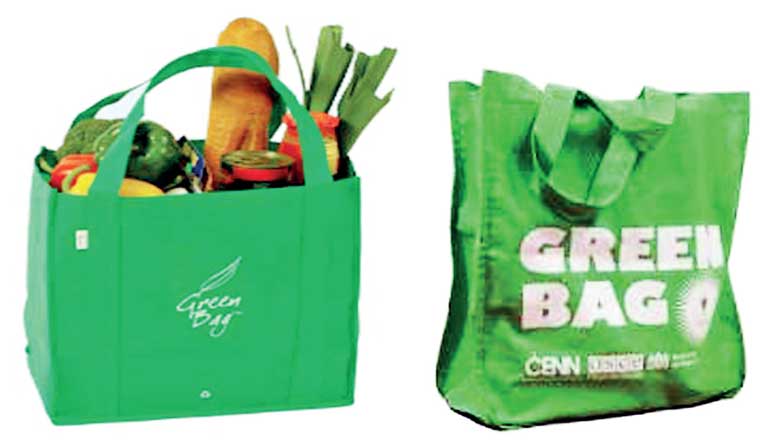Monday Apr 07, 2025
Monday Apr 07, 2025
Friday, 28 April 2017 00:00 - - {{hitsCtrl.values.hits}}
 Due to the amount of attention the Meethotamulla garbage dump collapse has given to garbage management and waste reduction, I thought this is a good time to relate the following.
Due to the amount of attention the Meethotamulla garbage dump collapse has given to garbage management and waste reduction, I thought this is a good time to relate the following.
It was way back in 2006 when I was visiting a Whole Foods store in North Carolina, USA that I saw this lovely green bag that they were packing the groceries in and I saw that the shoppers were bringing several of the same bags with them from home to take their groceries in. I thought what a simple idea and I bought one for myself at the checkout. It was only $1 if my memory is right.
At that time, I was working for Cargills Ceylon Ltd, the largest privately owned retail chain in Sri Lanka as a Group Director – Strategic Planning & Business Development. While I was in the US itself, while in my hotel room, I Googled about this bag and found out details about this bag, how it is made, of what type of material and the rationale for the design etc. Further, to my surprise, the makers of the bag say at the end ‘please copy us, because we want to save the planet’. That hit a cord in me!
I wanted to introduce the ‘Green Bag’ to Sri Lanka through the retail chain that I was working at. My research into the bag material found out that the bag is made out of ‘a 100% bio-degradable material’ that will completely degrade once thrown to the soil with no harmful residue. Immediately upon my return to Sri Lanka, I contacted Prof. Ajith de Alwis of the University of Moratuwa and told him that I want to know the details of this material and I need to find a company in Sri Lanka who can make it. The materials management department of the university quickly found out the material and I was able to find a company called ‘Celcius’ which was willing to manufacture the bag.
When I read about the design of the bag (which was also on the original website) I was even more thrilled to go ahead with the same exact design. The bag that we introduced at Cargills in 2006/7 had a broad base that would stay upright on a check out table at the super market cashier. It was designed to make it stay like that so that the bagger at the checkout can easily pack the items into the bag and also arrange them neatly in a way to use the space to the maximum. That’s not all, the bags handles have been designed so that the weight of the bag is equally spread to both sides so that it will not upset the shoppers shoulders or back when carrying it. I was really amazed at how much they have thought into this!
So my instructions to Kamal the CEO of Celcius was to make the exact same bag with the exact same material and design. They sold the bag to us at Rs 40 at that time.
When we introduced the bag to the supermarket, the immediate barrier was having to pay for the bag and the second barrier was that Sri Lankans were not used to bringing their own bag when going shopping. I used to nostalgically remember how I used to go shopping with my mother to the Marketing Department (MD) or to the Jathika Pola carrying a cane bag (kuude) full of other small bags to put the groceries in. However, with the introduction of the ever so convenient ‘sili-sili’ bag, the idea of carrying your own bag everywhere was unthinkable!
So the first challenge was to develop the habit of bringing their own bag, since actually the price of the bag was not a big thing to the supermarket consumer. We calculated the average number of bags for the average basket and found out that each customer will need at least three to four bags of these bags to put all their weekly groceries. So we introduced another concept, ‘BYOB’ which stands for ‘Bring Your Own Bag’ stemming from the ‘Bring Your Own Bottle’ parties concept! We had to figure out how to encourage the customers to get into ‘BYOB’.
So we introduced a promotion to ‘earn a point every time you bring your own green bag, and when you have earned 10 points you will get another bag free’. This was introduced by way of having a card tagged to the bag, and every time the consumer uses it at the cashiers, the cashier will put a seal on the card, at the end of the card (or 10 seals) you receive another bag and so on. After sometime, we went further and took a bold action to charge about 0.50c for every ‘sili-sili’ bag that the consumer uses, in order to encourage them to ‘BYOB’. The cost of this to the consumer was no more than Rs. 3-5 per visit, since on average about seven to 10 bags were used by a consumer as per our calculations, if you are buying your weekly groceries, otherwise it was even less.
However, one smart(?) citizen went to courts against the super market chain, saying that charging for the bag is a violation of their rights! So much so for this self-righteous consumer who could not see the bigger picture of what we were trying to do. Anyway, so we gave up charging the consumer and instead we started offering the cost of the bags as a discount to the consumer if he/she adopts BYOB.
As a result of all these, we definitely saw a decrease in the amount of bags used by the supermarket chain. I am not sure for how  long that was continued since I left Cargills around that time to join the government. The bag became very popular, and consumers were using it to go anywhere and everywhere, because it was a hardy bag with ample space and easily foldable and hardly weighs anything when empty. Every time I see this bag carried by a person on the street I felt so proud and happy.
long that was continued since I left Cargills around that time to join the government. The bag became very popular, and consumers were using it to go anywhere and everywhere, because it was a hardy bag with ample space and easily foldable and hardly weighs anything when empty. Every time I see this bag carried by a person on the street I felt so proud and happy.
Very soon, two other retail chains, Keells and Arpico followed suit and Keells introduced a ‘Red Bag’ and Arpico introduced a ‘Blue Bag’. They were going with their corporate colours, but did not probably know the idea of the ‘Green Bag’ was to remind people that using a re-usable bag is about ‘Going Green’ and protecting the environment. Later on, I saw that even Cargills introduced bags of all colours. So now I am told there are many suppliers who have got into the business of making these bags, which is good. Regardless of the colour, I do hope that the material is bio-degradable because otherwise a big part of this Green Concept is lost.
I am glad that something that I managed to introduce is been continued to some extent, but it has definitely not reached the full potential of the concept to bring a significant impact. Now when I go to the super market, and the cashier asks me, ‘Madam, do you have a Red Bag or Green Bag?’ I feel so proud and I ask them, ‘Why do I need to have the bag?’ just to test out to see whether they know the reason, most of them talk about the points I can earn but a few explain correctly. I listen with a smile, sometimes feeling very guilty that I have left my bag in the car and feel lazy to go and bring it.
Why I thought of writing this story now is, I think even in the backdrop of the terrible tragedy that happened at Meethotamulla, I feel we have an opportunity of getting the attention of the Sri Lankan consumer to contribute to ‘Reduce, Reuse, Recycle’ at this stage. A supermarket chain had this vision almost 10 years ago, and the bags have been there for that long. Think to yourself, have I done even a small effort like this to reduce, reuse, recycle? Most Sri Lankans are frustrated and desperate and thinking what can I as a Responsible Citizen do to help the country get out of this mess? So here’s your opportunity to play a part, and start from today, to not to use any sili-sili bags hereafter and instead carry your own re-usable bag!
(The writer is the Founder, Chairperson of Mother Sri Lanka Trust, a charitable foundation focusing primarily on developing Responsible Citizenship and Chairman of Go Green Solutions. She is also a former Chairperson – Sri Lanka Tea board, Chairperson – Regional Development Bank, Director – Cargills Group and MD – Nielsen Lanka.)
Discover Kapruka, the leading online shopping platform in Sri Lanka, where you can conveniently send Gifts and Flowers to your loved ones for any event including Valentine ’s Day. Explore a wide range of popular Shopping Categories on Kapruka, including Toys, Groceries, Electronics, Birthday Cakes, Fruits, Chocolates, Flower Bouquets, Clothing, Watches, Lingerie, Gift Sets and Jewellery. Also if you’re interested in selling with Kapruka, Partner Central by Kapruka is the best solution to start with. Moreover, through Kapruka Global Shop, you can also enjoy the convenience of purchasing products from renowned platforms like Amazon and eBay and have them delivered to Sri Lanka.
Discover Kapruka, the leading online shopping platform in Sri Lanka, where you can conveniently send Gifts and Flowers to your loved ones for any event including Valentine ’s Day. Explore a wide range of popular Shopping Categories on Kapruka, including Toys, Groceries, Electronics, Birthday Cakes, Fruits, Chocolates, Flower Bouquets, Clothing, Watches, Lingerie, Gift Sets and Jewellery. Also if you’re interested in selling with Kapruka, Partner Central by Kapruka is the best solution to start with. Moreover, through Kapruka Global Shop, you can also enjoy the convenience of purchasing products from renowned platforms like Amazon and eBay and have them delivered to Sri Lanka.